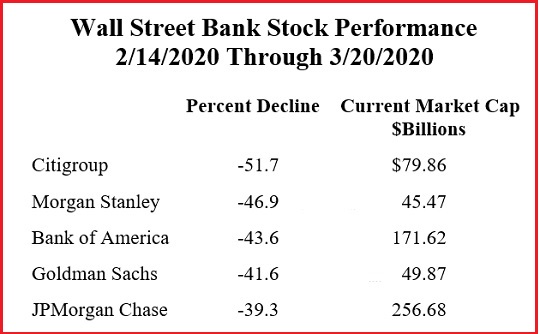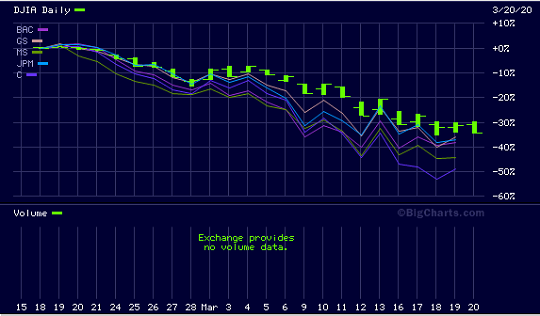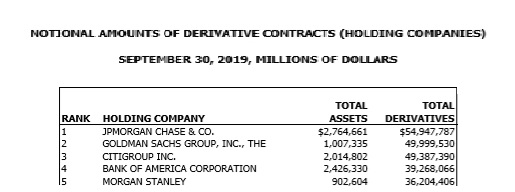By Pam Martens and Russ Martens: March 21, 2020 ~
Above is the chart that has the Federal Reserve and its Wall Street money funnel (a/k/a New York Fed) chewing on their worry beads and rapidly rolling out their alphabet soup of Wall Street bailout programs in a replay of their playbook during the 2007-2010 Wall Street collapse.
While Fed and Treasury officials have been repeatedly assuring Americans that these Wall Street behemoth banks have plenty of capital, they’ve actually been bleeding their common equity capital faster than a snow cone in July. In just the past five weeks, from the close of trading on Friday, February 14 through the close of trading on Friday, March 20, five of the largest Wall Street banks have lost an average of 45 percent of their common equity capital.
Adding to the embarrassment for the Federal Reserve, Citigroup, the bank it propped up with $2.5 trillion in secret cumulative loans the last time around, is once again leading the herd with losses in its common equity capital. Citigroup’s market capitalization has lost a stunning 51.7 percent in just the past five weeks. And we are certainly in the early innings of this bank rout.
Morgan Stanley, which was second in line behind Citigroup at the Fed’s trough in the last financial crisis, receiving $2.04 trillion cumulative in secret revolving loans, has lost 46.9 percent of its common equity capital in just the past five weeks.
Just last week alone, the five Wall Street behemoths listed in the chart above lost a combined $154.45 billion in common equity capital.
As the chart below indicates, the losses in these Wall Street bank stocks dwarfs the losses in the broader market as measured by the Dow Jones Industrial Average – meaning that despite what U.S. Treasury Secretary Steve Mnuchin says, there is a Wall Street bank problem that is being aggravated by the coronavirus outbreak but whose roots are independent of it. (See our in-depth series on the current banking crisis here.)
As we illustrate in the top chart, the total common equity capital for the five mega banks is just $603.5 billion. But as of September 30, 2019, according to the regulator of national banks, the Office of the Comptroller of the Currency, those same five bank holding companies held $230 trillion in notional (face amount) of derivatives – the bulk of which were buried in private contracts between themselves and a counterparty, with little to no visibility to their federal regulators.
This was the precise situation that brought down the U.S. banking system and U.S. economy in 2008. The fact that millions of innocent, hardworking Americans are once again losing their jobs and their livelihoods and their 401(k) retirement savings because Congress allowed Wall Street’s crony regulator, the Federal Reserve, to remain as the regulator to the Wall Street bank holding companies after the unprecedented corruption that brought down Wall Street in 2008, is a crisis of leadership that transcends both political parties.




